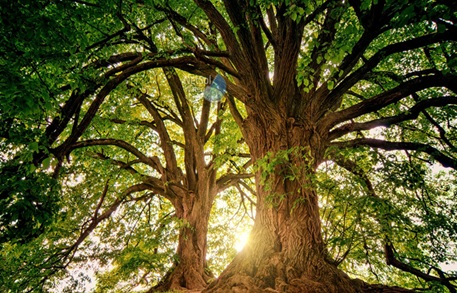Introduction
Trees are not just passive and aesthetic objects but important elements that shape the environment. Recent research has shown that the environmental benefits of trees, such as cleaning the air, preventing floods and absorbing carbon dioxide, are a result of their ability to regulate the environment. Trees play an important role in bringing rain, redistributing water and building soil.

Environmental Role of Trees
- Trees are often seen as just green scenery or environmental decoration but in reality they are the creators of the earth's ecosystem. After thousands of years of evolution, trees have developed the ability to control the basic elements like water, air, fire and soil.
- According to Harriet Ricks (The Genius of Trees, 2025, Bodley Head), trees are not victims of change but active agents of change. When modern humans evolved about 40,000 years ago, there were an estimated six trillion trees on Earth, which had already changed the air, water flow and relationships with other species.
- Trees not only bring rain, but also send water back to the atmosphere through evaporation. Their roots collect and redistribute water beneath the soil.
- This process is so efficient that trees can better regulate water even during climate change. From an ethical perspective, this contribution of trees reminds us of the responsibility to protect them because they keep the elements necessary for life balanced.
Wood Wide Web: A communication network of trees
- Trees communicate and cooperate not only for themselves, but also with other species. Recent research has brought forth the concept of 'Wood Wide Web' in which trees form complex networks with fungi beneath the soil. Through this network, trees exchange resources (such as nutrients and water).
- Suzanne Simard (Finding the Mother Tree: Discovering the Wisdom of the Forest, 2021, Allen Lane) says that trees 'talk' to each other and show 'love' which reflects their community spirit.
- Although some scientists question this humanization, it is clear that this network of trees strengthens the ecosystem.
- Morally, it teaches that every species in nature is dependent on each other. This cooperative behavior of trees inspires cooperation and community in human society.
Historical contribution of trees
- Trees have been among the largest organisms on Earth for about 400 million years. With their cooperation, rocks broke down to form soil, water flowed in rivers and oxygen was emitted, making the atmosphere conducive to life. Without trees, the Earth would have been a desert. This historical contribution awakens a sense of gratitude towards trees.
- From a moral point of view, it has to be understood that trees have made the earth habitable and it is the duty of man to protect them.
Sacred trees and moral values
- Vasudha Rai (Sacred: The Mysticism, Science, Recipes and Rituals, Ebury 2025) in her book highlights the scientific and spiritual importance of 'sacred' trees like Peepal, Banyan, Rudraksh and Deodar.
- In India, about fifty species are considered sacred which are associated with our cultural and religious traditions. Rai explains that the importance of these trees is not only spiritual but also scientific because they support the ecosystem.
- From a moral point of view, every tree should be considered sacred because every tree supports bacteria, insects, bees, birds and mammalian species. Ancient scriptures say that every leaf, twig and stem is the home of the spirits of nature.
- In an ancient story, a guru asks his disciple to find a plant in the forest which has no use. The disciple returns empty-handed as he does not find a single plant. The tale teaches that every part of nature is valuable and humans must take the moral responsibility to preserve it.
Conclusion
Trees are not just decorative parts of the environment; they are the protectors of life and creators of ecosystems. Their collaborative network through the ‘Wood Wide Web’ and scientific basis of sanctity inspire us to respect and preserve nature. Morally, it must be understood that tree conservation is not only an environmental but also a cultural and spiritual responsibility. Humans must regenerate their symbiotic relationship with trees so that we can secure a healthy and balanced earth for future generations.



